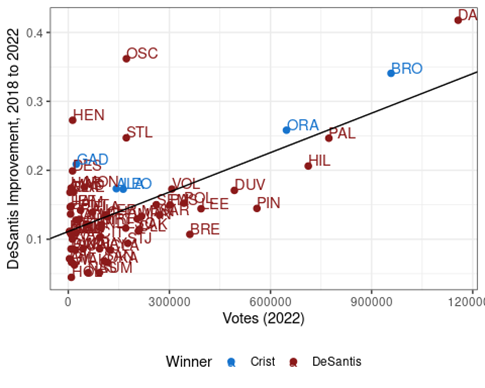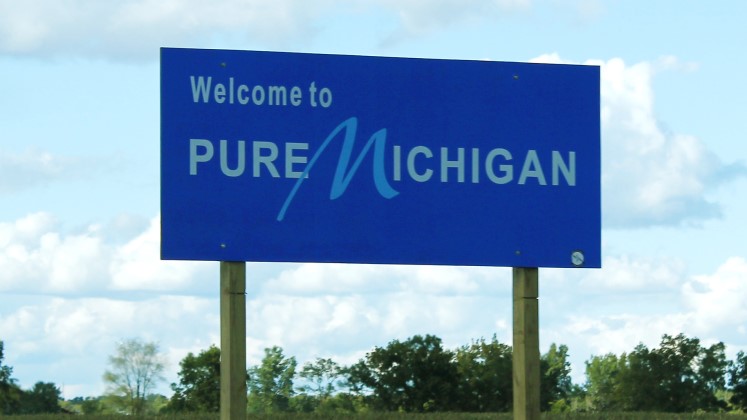 In the summer of 2023, Donald Trump’s commanding lead in Republican Party presidential primary polls suggests that he is very likely to be the GOP’s presidential nominee next year. Kevin Fahey takes a close look at the recent political fortunes of Trump’s main challenger, Florida Governor, Ron DeSantis. He writes that DeSantis overperformed Trump’s improved 2016-2020 vote share in his own re-election as governor in 2022. Evidence from Florida shows that DeSantis may be able reach urban and suburban voters in key 2024 battleground states, making him more likely to beat Joe Biden in the presidential election, compared to Trump, who is only solidifying support with rural voters.
In the summer of 2023, Donald Trump’s commanding lead in Republican Party presidential primary polls suggests that he is very likely to be the GOP’s presidential nominee next year. Kevin Fahey takes a close look at the recent political fortunes of Trump’s main challenger, Florida Governor, Ron DeSantis. He writes that DeSantis overperformed Trump’s improved 2016-2020 vote share in his own re-election as governor in 2022. Evidence from Florida shows that DeSantis may be able reach urban and suburban voters in key 2024 battleground states, making him more likely to beat Joe Biden in the presidential election, compared to Trump, who is only solidifying support with rural voters.
- ‘This article is part ‘The 2024 Elections’ series curated by Peter Finn (Kingston University). Ahead of the 2024 election, this series is exploring the US elections at the state and national level. If you are interested in contributing to the series contact Peter Finn (p.finn@kingston.ac.uk).’
Governor Ron DeSantis (R-Fl) will not be President of the United States. Nor will he be the Republican nominee for President in 2024, barring some unforeseen calamity that befalls current GOP front-runner (and former President) Donald Trump. Trump’s polling lead, according to FiveThirtyEight, is around 30 percentage points. Further, the Republican Party has rewritten state delegate counts to allow him to win all a state’s delegates with a plurality of the vote, preventing a contested convention.
That said, were Trump to drop out, and DeSantis to win the Republican nomination, he would assemble a coalition of voters that would be likely to win the Presidency in 2024. This coalition differs from Donald Trump’s in some small but important ways. In this post, I outline those differences. Specifically, DeSantis’ improvement among Florida’s urban and suburban voters appears to reflect a national trend that could result in a DeSantis victory over Democratic President Joe Biden in 2024.
Florida Gubernatorial Results, 2022 and 2018
Both Governor DeSantis and former President Trump did better in their re-election campaigns in Florida than in their initial campaign. Their improvement – a measure of their performance in their re-election campaign than in their first campaign – is noticeable across the state. DeSantis’ overall increase from 49.6 percent of the vote in 2018 to 59.4 percent of the vote in 2022 is larger than Trump’s increase from 49.0 percent of the vote to 51.2 percent of the vote. Yet DeSantis performed better than Trump in a few noticeable parts of the electorate. DeSantis’ 2022 gubernatorial win – in which he won 62 of Florida’s 67 counties – included large swings to him in the urban and suburban parts of the state.
In Figure 1, I show DeSantis’ improvement, county-by-county, from his 2018 first election to his 2022 re-election. Bright yellow refers to relatively poor improvement – although DeSantis’ worst improvement was nevertheless 4.4 percentage points – while dark purple refers to relatively high improvement.
Figure 1 – DeSantis trend 2018-2022, Florida Gubernatorial Elections

Notice DeSantis’ improvement in places with more votes – even in counties normally considered to lean Democratic such as Miami-Dade and Palm Beach counties in the state’s southeast or Hillsborough County in the Tampa metro – suggests his inroads among urban and suburban voters that, so far, are hesitant to vote for Donald Trump. In Figure 2, I show the correlation between DeSantis’ improvement and the size of the county electorate (counties won by DeSantis in read, counties won by former Florida Governor and member of Congress, Charlie Crist in blue):
Figure 2 – DeSantis gubernatorial vote improvement by county 2018-2022

DeSantis compared to Trump, 2022 to 2020
How did each candidate’s improvement stack up? In the following map (Figure 3), we see that DeSantis’ improvement was better than Trump’s in the urban and suburban parts of the state, while Trump’s improvement was better than DeSantis’ in the rural parts of the state. What I’ve done here is compare improvement for DeSantis, 2018-2022, to improvement for Trump, 2016-2020, subtracting Trump’s improvement in vote share from DeSantis’ improvement in vote share. The brighter the yellow, the greater the relative improvement for Trump, while the darker the green, the greater the relative improvement for DeSantis.
Figure 3 – DeSantis trend compared to Trump, Florida elections

DeSantis’ improvement over Trump is across-the-board. This is certainly in part due to the quality of the Democratic candidate in both races; while President Biden won nationwide, Democrats’ gubernatorial candidate Charlie Crist faced considerable headwinds. But the variation across the state offers DeSantis lessons in the unlikely chance he is allowed to compete with Biden for the presidency.

“President Trump Meets with the Governor” (Public Domain) by The Trump White House Archived
Notably, Trump maintains an edge in the Florida Panhandle – a part of the state which propelled him to victory in 2016 – the rural northern counties in Florida, and Miami-Dade itself, but few other parts of the state. DeSantis’ improvement in urban and suburban counties across the state – where most of Florida’s voters live – is a model that could be applicable to other Southern battleground states such as Georgia, North Carolina, or even Texas and its rapidly-growing urban centers. This ‘suburban edge’ might also blunt Democrats in Pennsylvania, Michigan, and Wisconsin, three states Republicans must win to retake the presidency.
The following bubble graphic (Figure 4) underscores this issue. While Trump’s overperformance maps onto DeSantis’ in low-population counties, DeSantis’ improvement is substantially higher in the higher-vote, more-competitive counties that Biden won or nearly won in 2020.
Figure 4 – Trump and DeSantis improvement 2018-2022 and 2016-2020

This matters for the presidential race. Trump has shown he can energize rural voters, but in both 2016 and 2020 it was insufficient to translate into a popular-vote victory. In 2020 in particular, rural voters turned out at extraordinary high rates, but Democrats were able to win urban and suburban voters, swamping Trump’s base.
DeSantis appears – at least in Florida – to have reversed the trend, and could convert this new coalition into a victorious one at the ballot box.
DeSantis vs Biden, 2024
Current President Joseph Biden (D) faces a uphill fight for re-election, unless his opponent is former President Trump. Biden’s approval ratings are historically low, perceptions of the economy are poor, and with Republican control of the House of Representatives, Biden’s chances of getting major policy reforms through Congress are non-existent. Indeed, it is possible that due to redistricting changes, Biden could lose quite easily re-election while Democrats win control of the House and retain control of the Senate.
Public opinion polling at this early stage is uninformative of presidential results. And the 2024 general election is likely to be decided in a small handful of states, regardless of who the two general-election candidates are (there is little political room for a third-party candidate to be successful).
That said, polling in the small set of swing states suggests that DeSantis outperforms Trump in head-to-head races with President Biden in states that truly matter. The analysis of DeSantis’ performance compared to Trump’s suggests that DeSantis may be able to outperform Trump’s 2020 showing in urban and suburban areas, directly threatening the coalition Biden assembled in 2020.
Aggregate public opinion polling found on Wikipedia shows that DeSantis has a clear edge over Trump in head-to-head contests versus Biden. In particular, DeSantis fares better than Trump in battlegrounds or large-electoral-vote hauls such as Michigan, Ohio, Virginia, North Carolina, Florida, New Mexico, Colorado, and Nevada. Forcing Democrats to play defense in Colorado, New Mexico, and Virginia would make for a much more difficult map for Biden’s re-election strategy. By contrast, Trump’s polling leads suggest that he is doing very well in safe Republican states but is less competitive in battlegrounds.
Figure 5 – DeSantis (L) and Trump (R) head-to-head statewide polling against Joe Biden, 2024 presidential election

Comparison of the two shows that DeSantis would be a much more competitive general-election challenger. In the map below, the darker the green, the stronger DeSantis is relative to Trump against Biden, while brighter yellow indicates that Trump is stronger relative to DeSantis. Trump does very well in safe Republican states, but does not fare well in the Mountain West, the Midwest, or the Atlantic coastal states.
Figure 6 – DeSantis margin over Trump, by state

DeSantis has a chance
Again, I reiterate: there is virtually no chance that Ron DeSantis will win the Republican party’s nomination for president, barring a major catastrophe that befalls front-runner Donald Trump. But if he did manage to win the Republican nomination, what are the main ‘’takeaways?’’ I offer three.
First, DeSantis has an opportunity to present himself to Republican voters as an electable anti-Trump, and if he pursues a more moderate path – even despite his notoriety for taking on the Disney Corporation – could defeat Biden. A Trump nomination is a gift to Biden, as Trump’s Florida improvement suggests he is only really capable of rousing rural voters. If rural voters remain a minority of the country’s population, then Trump may consign Republicans to another four years in the political wilderness.
Second, DeSantis may harm his primary appeal by trying to tack right. Given that many states let voters switch parties to vote in primaries or vote in primaries regardless of party affiliation, and with DeSantis’ appeal to a different section of the electorate than Trump, he could increase his appeal in the Republican electorate by trying to win over suburban and urban Republicans and independents.
Third, DeSantis may have already squandered an opportunity for Florida Republicans to firmly move the state rightward. In the wake of the 2022 election, he has chosen to double-down on litigation with the Disney Corporation and pursuit of an ‘anti-woke’ agenda, all while inflation and housing prices both stay higher-than-average.
- Please read our comments policy before commenting.
- Note: This article gives the views of the author, and not the position of USAPP – American Politics and Policy, nor the London School of Economics.
- Shortened URL for this post: https://bit.ly/3Dkklt7






